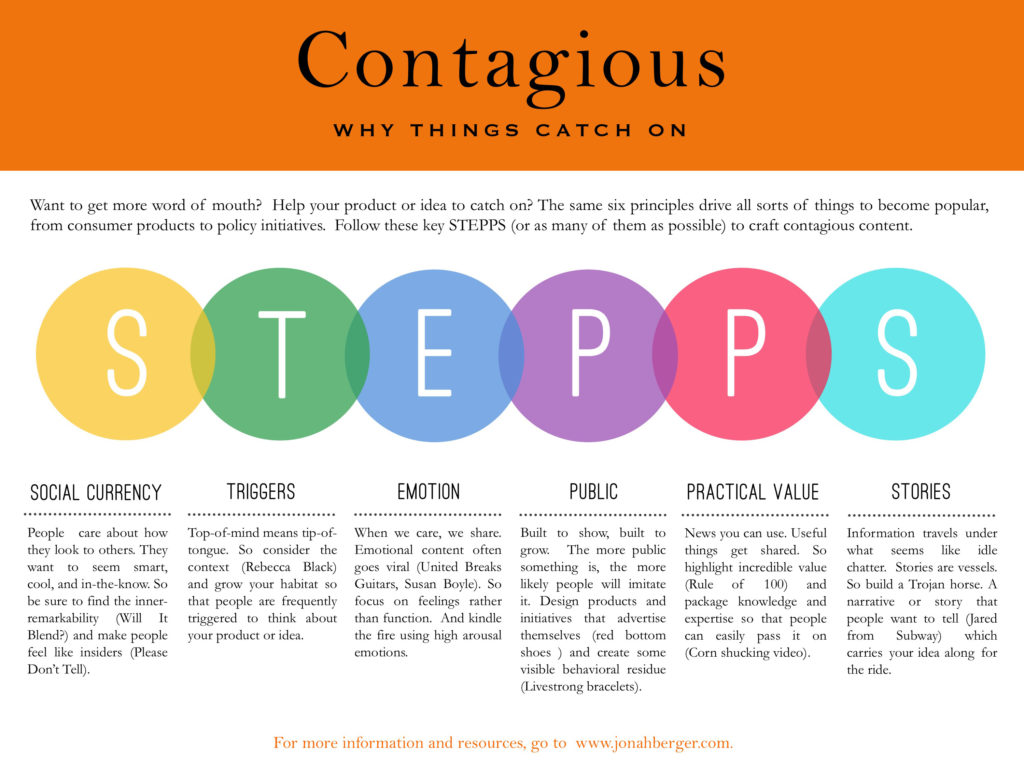How do you create engaging content to go viral on social media? Wharton Business School Professor Jonah Beger created a framework to guide in this process. The framework is called STEPPS, which is outlined below:

Social Currency
Concept
- Purchase = Exchange of money for goods
- Purchase = Desired information for Belonging/Unique
3 ways to achieve this
- Remarkable
- Identify what’s remarkable about your brand that will make someone look good if they shared it
- Game mechanics
- Social media is game mechanics – always looking to see how many likes we get
- Angry Birds
- Make people feel like insiders
- Make them feel like an insider
- Provide insider information
Triggers
- Play on what’s top of mind
- Formula: When I think of X, I am reminded of Y
Two ways to accomplish this:
- Play on pop culture or current events
- What is popular in the news right now, or what is your target constantly talking about?
- How can you attach this to your brand?
- Oreo Example
- In the 2012 Super Bowl, the stadium lights went out during half time
- Oreo tweeted this:
- Create a name association
- When people think of your brand, what do you want them to think about?
- In order to develop a true name association, the following must occur:
- The association must be believable in the mind of your consumer. Ex: McDonald’s is not going to create a brand association that they are the healthy choice
- The association must be CLEARLY front and center in the campaign
- Heavy consistency and branding is needed for the association to stick
- Kit Kat “Break” Campaign
- During work day when you stop for 15 minutes?
- What do people normally get during their break?
- Agree people associate coffee with break?
- What is Kit Kat’s slogan?
- Is it an easy trigger for them to associate COFFEE with BREAK
- Break time, anytime Kit Kat tv commercial (market)
- Nestle KitKat Commercial 2016 The Break Off
- New Kit Kat Ad – Checkout
Emotions
When we care we share
- Share content that is congruent with the emotions of your target market
- This will heavily rely on the motivations of belonging, individualistic, and altruistic
- Examples of some emotions can include:
- Nostalgia
- Inspiration
- Compassion
- Love
- Justice/Injustice
- Humor
Public
- People will copy what others are doing
- This will create social proof
- How can you encourage other people engaging your brand in public?
2 ways in the context of social media
- User Generated Content
- Encourage consumers to publish posts of them using your product
- Example: Share a Coke
- Coke released bottles with people’s name on them
- This influenced people to post images of them with a Coke bottle that had their name on it
- ‘Share A Coke’ campaign …Coca Cola, a marketing genius!!!
- Hashtags
Practical
- People will engage with useful information that is simple and practical
Ways to do this
- First, identify information your consumer wants to know (the key is they must WANT to have it)
- How to achieve a goal
- How to overcome a problem (Hennig-Thurau et al., 2004
- Provide this information in a format that is simple and easy to understand
- How to guides
- Cheat sheets
- Webinars
- Instructional videos
- Podcasts
Examples
- Tasty.co
- Entreupreneur.com
Stories
It is human nature to process information through narratives, not a list of facts. When brands tell stories, it humanizes a brand and makes it relatable. Stories of people using a product, testimonials, and personal stories of triumph all increase the virality of content.
3 Essential Elements of Story Telling
Characters
- List the characters who are involved in the story
- Describe their personas
- Make the audience empathize with their wants, needs, joys and problems and relate to audience
- Conflict
- Builds emotional dynamic
- No conflict – then it’s a sales pitch
- Be genuine, not over the top
- Should be in line w prospect’s needs, wants, problems
- Resolution
- Display the victory
- Call to action
- Next steps





